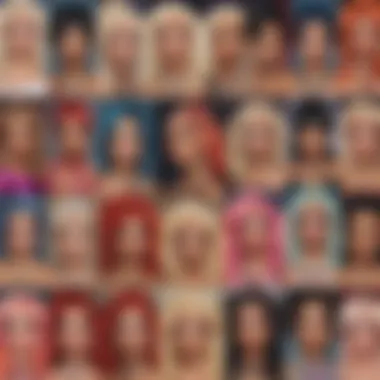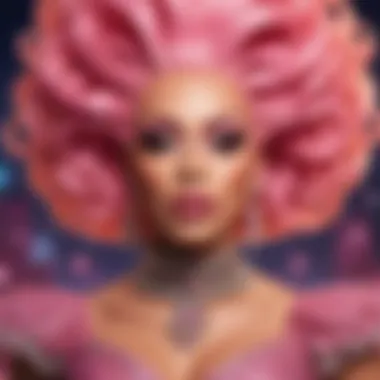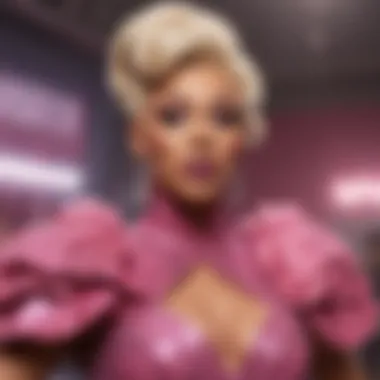Exploring RuPaul's Drag Race: Seasons Unveiled and Analyzed


Intro
RuPaul's Drag Race stands as a benchmark in reality television, captivating audiences worldwide since its debut in 2009. The series, crafted by World of Wonder and hosted by the iconic RuPaul Charles, showcases the art of drag, blending performance, fashion, and fierce competition. Each season is characterized by various challenges, thematic episodes, and a pool of diverse contestants, all vying for the coveted title of
Intro to RuPaul's Drag Race
RuPaul's Drag Race represents a watershed moment in the convergence of entertainment, culture, and social discourse. It is essential to position the show not just as a television series but also as a cultural phenomenon influencing many aspects of modern society. This introduction serves as the stage for dissecting the complexities of each season, the cultural reflection they provide, and the repercussions of the narratives woven within the performances.
The Premise of the Show
At its core, RuPaul's Drag Race unveils the artistry and craft of drag through competition. Contestants showcasing their talents face various challenges that test their versatility, creativity, and aptitude for performance. Each season hosts a blend of lip-sync battles, runway presentations, and unique acting challenges, ultimately culminating in a grand finale where one contestant is crowned America’s Next Drag Superstar. Furthermore, RuPaul Charles, the host and commanding figure in this domain, plays a pivotal role in steering discourse within the context of the show, proposing challenges and highlighting transformative narratives around identity.
Cultural Significance
RuPaul's Drag Race surpasses its status as mere entertainment; it reflects and challenges societal norms marking boundaries of gender and identity. The series not only elevates drag culture but also subverts traditional mainstream perceptions. Here are few of its impactful aspects:
- Visibility: The presence of queens on a global platform has opened discussions regarding LGBTQ+ rights and issues ashamed in many societies.
- Audience Engagement: The colorful rivalries and heartwarming stories of queer narratives have engaged audiences from different backgrounds, thereby producing a diverse fan base that celebrates differences.
- Fashion and Artistry: Contestants often serve as cultural ambassadors, showcasing various styles and trends that ripple into wider fashion markets and artistic communities.
"Drag empowers individuals by giving them freedom to express through art; it also urges us to reflect on our definitions of identity and gender."
In evaluating the initial segments of RuPaul's Drag Race, it becomes increasingly clear that the show does much more than entertain; it interrogates our collective understanding of who we are and where we fit within society. The nuances found in the layers of this program warrant further exploration as the seasons unfold, each revealing new themes and insights that prompt dialogue in the cultural landscape.
Season Overview
The concept of a Season Overview is key in understanding the changes and developments within RuPaul's Drag Race. Each season not only presents a group of contestants but also serves as a time capsule reflecting societal attitudes and creative evolution in drag culture. Focusing on a comprehensive overview allows fans and casual viewers alike to gain perspective on the show’s trajectory. Through this lens, one can see how the series progressively addressed contemporary issues and refined its competition format across seasons.
Moreover, analyzing each season aids in identifying recurring themes and character arcs. The significance of cultural representation during different periods resonates deeply with the audience. Each overview shines a spotlight on how drag has influenced popular culture. Thus, the Season Overview is essential for a layered understanding needed in this complete analysis.
Season One Highlights
The inaugural season of RuPaul's Drag Race debuted in 2009, setting a tone for competitive reality shows featuring drag queens. Season One showcased nine contestants, each vying for the title of
Notable Contestants Across Seasons
RuPaul's Drag Race stands as an influential landmark in reality television, largely due to its memorable contestants. Each season showcases individuals who become cultural icons. Evaluating these contestants is essential, as they personify the various directions the show has taken and its influence on broader culture. This analysis facilitates understanding how personal stories, performances, and artistry shape the overall narrative of the series. Furthermore, it highlights the growth and challenges associated with identity, creativity, and representation within the drag community.
Pioneering Queens
Some queens set benchmarks for performances and societal contributions within the drag community. From the earliest contestants, there have been those whose artistry brought a new identity to drag. For example, Bianca Del Rio merged humor with a sharp critique of pageantry. Her win in Season 6 shifted the perception of drag, emphasizing intellect alongside glamor.
Another notable figure is RuPaul himself, who not only hosts but also continuously influences the drag landscape. Similarly, contestants like Raven and Jinkx Monsoon elevated the standards of performance with their unmistakable artistry and wit. They have pioneered ways drag queens communicate, reflect, and challenge societal notions through performances, proving drag as a potent medium for self-expression and advocacy.
Fan Favorites
Every season of RuPaul's Drag Race introduces contestants who capture the audience's hearts. These queens often demonstrate a remarkable capacity to connect, making their presence memorable. A notable example is Sasha Velour from Season 9. Her combination of creativity and vulnerability made her not just a competitor but also a person fans could relate to.
Similarly, Katya Zamolodchikova stands out for her unique blend of authenticity and humor. She has transcended the role of a contestant, engaging in different media, proving that the connection with fans extends far beyond the confines of the show.
Queens become fan favorites often because of relatability, humor, and expressed authenticity encapsulated in each episode. Their impact resonates through social media engagement and dedicated fan art, fostering a vibrant online community centered around these figures.


Controversial Figures
In any competitive arena, controversy is often inevitable. RuPaul's Drag Race has its share of reducers and villains, shaping discussions around the show itself. Figures like Fifi O'Hara brought intense scrutiny from fanbases and the queens alike, sparking debates about behavior and the essence of competition.
Similarly, the introduction of conflict-oriented edits in certain seasons raised eyebrows. This not only challenged traditional concepts of fairness but also opened up discussions about representation and editing in reality television. These moments exposed the underlying tensions within the drag community, fostering dialogues around ethics and self-presentation.
Overall, the notable contestants of RuPaul's Drag Race mirror society's complexities and the nuances existing within the drag culture. These characters contribute to a significant narrative shaping both the series and cultural perceptions of drag. Forming an essential part of any comprehensive discussion, their journeys reveal how performance art can instigate deeper discussions about gender, identity, and societal expectations.
Challenges and Themes
The challenges and themes presented throughout RuPaul's Drag Race serve as a critical framework for understanding the dynamics of the show. These challenges not only test the contestants' creativity, skill, and adaptability, but they also reflect deeper societal issues and cultural narratives. Each challenge provides insight into the form and function of drag as an art form, showcasing how it intersects with contemporary themes such as gender identity, love, and self-acceptance. In analyzing these challenges, viewers gain a clear perception of how the series engages with, critiques, and reinforces various themes that resonate beyond the screen.
Signature Challenges
RuPaul's Drag Race is well known for its unique signature challenges that set the show apart from other reality competitions. Here are some of the signature challenges featured throughout the seasons:
- Snatch Game: This iconic impersonation challenge allows contestants to showcase their ability to embody various celebrities. It's not just about looks; wit and humor are key, making it a test of versatility.
- Lip Sync for Your Life: This elimination challenge is pivotal. Contestants perform a lip sync battle, which acts as a high-stakes moment where emotions run high. The sheer intensity and artistry required to succeed makes it unforgettable.
- Fashion Runway: Contestants are tasked with presenting their best looks based on different themes. This challenge highlights attention to detail, craftsmanship, and creative expression in fashion.
- Rusical: A combination of musical theater and drag, this challenge demands performance skills and creativity. Contestants prepare a musical number that often carries a storyline related to drag culture.
Each of these challenges serves a greater purpose, acting as a microcosm of broader themes like personal growth, rivalry, and artistry in the drag world, contributing to the narrative arc of each season.
Thematic Arcs Throughout Seasons
Across its many seasons, RuPaul's Drag Race introduces and develops a variety of thematic arcs that resonate with audiences. These themes play a crucial role in defining the competition and showcasing the personal journeys of contestants:
- Self-discovery and Identity: Many queens express personal stories regarding their transition and acceptance of their identity throughout the series, aligning heavily with the overall narrative of the show.
- Empowerment: The drag community promotes empowerment, giving participants a platform to share their experiences and strengths, embodied vividly within the show's narrative.
- Community and Unity: Despite competition, the love and support among contestants often highlight the importance of community within the drag scene. Collaborations and partnerships shine a light on togetherness.
- Resilience: Contestants often face challenges beyond the view of the audience. Their perseverance becomes a central part of their stories, showcasing how resilience contributes to success both in and out of competition.
In summary, the challenges and themes in RuPaul's Drag Race dramatically shape the contestants' journeys and the audience's experience. By situating these elements within the broader social context, the series has enriched discussions around topics that are significant not just in drag culture, but in the greater landscape of entertainment and society.
Impact on Pop Culture
RuPaul's Drag Race has reshaped not only reality television but prompted broader conversations about identity and acceptance in contemporary culture. Through its unique presentation, it has bridged the gap between underground drag and the mainstream, positioning itself as a pivotal platform for queer representation.
Influence on the Drag Community
The impact of RuPaul's Drag Race on the drag community is profound. Prior to the show, drag was often confined to niche spaces and queer nightclubs. Now, it thrives in popular culture, with increased visibility beyond traditional circuits. Many contestants have transitioned the external fame they gain on the show into successful careers in various entertainment facets, including music, fashion, and television.
Alienation previously felt within the community is decreasing, as the program offers a sense of connection among performers and fans alike. Schools and workshops dedicated to drag artistry flourish, with more individuals developing an interest in drag culture. Events such as Drag Queen Story Hour are emerging, further embedding drag as a connector of diverse communities.
Global Adaptations of the Series
The phenomenon of RuPaul's Drag Race has transcended its American roots, inspiring various international adaptations. This global reach is significant not only as an exploration of local drag cultures but also in understanding the show's universal themes of self-expression and love. Each adaptation retains the core of the original format while introducing unique twists that reflect local customs and preferences.
International Versions
Numerous countries have produced their own versions of Drag Race, each interpreting the foundational elements in diverse ways. For instance, UK’s RuPaul's Drag Race UK has seamlessly integrated British humor while maintaining the show's competition format. The fanfare surrounding performers such as The Vivienne and Bimini Bon Boulash exemplifies how the British version connects with its audience through cultural references and community resonance.
In contrast, Drag Race Thailand embraces the vibrant theatricality and beauty present in Thai drag. With a focus on artistry, it showcases talent not commonly found in other adaptations. This version has, however, also been criticized for straying too far into commercial territory, highlighting the complexities of interpreting a beloved format.
Mexico’s La Más Draga adds a localized flair by infusing elements rich in Mexican traditions and politics. Each international version reflects domestic realities, community dynamics, and varying drag aesthetics.
Key features observed in many versions include:


- Cultural Nuances: Provision of unique wisdom shapes the journey of the contestants, focusing on locally relevant themes.
- Diverse Contestants: A display of varied gender expressions, body types, and personalities draws larger audiences.
- Adapted Challenges: Localized challenges cater to cultural context, often making them more relatable to nationals.
Local Cultural Interpretations
The representation of local culture in these adaptations is where the true beauty unfolds. While maintaining the essence of what makes Drag Race appealing, these shows highlight regionalifferent values, conflicts, and styles.
For instance, the differing societal attitudes towards drag and LGBTQ+ individuals in various cultures can lead to vastly different receptions of similar themes. In gay-friendly locales like Canada, Canada’s Drag Race celebrates inclusivity openly, inviting a receptive audience to actively relate.
Contrasting that, adaptation attempts in more conservative regions may face challenges. Local audiences sometimes grapple with the themes presented, forcing adaptations to find a delicate balance between maintaining the show's spirit and adhering to sociocultural expectations. This dilemma adds a layer of complexity to how drag is presented.
Through these adaptations, observers can discern how culturally embedded expressions flourish in different societies. It opens a dialogue on identity, self-acceptance and the ongoing fight for human rights within the LGBTQ+ community across the globe, showcasing the nuanced ways the series integrates into the fabric of local cultures.
Capture the essence of local drag culture and flaunt the artistry.
RuPaul's Drags Race as a concept is a canvas that continues to be painted over with hues of local artistry and experiences, contributing a mosaic rich in variety for both fans and participants alike.
RuPaul's Influence as Host
RuPaul Charles stands as a cornerstone of the series, shaping not only the show but also the broader perception of drag culture and representation on television. As a prominent gay icon, RuPaul has leveraged his platform to promote inclusivity while transforming the drag artistry into a celebrated form of entertainment. In this section, we explore RuPaul's multifaceted influence as a host, focusing specifially on personal branding and his role model status.
Personal Branding
RuPaul's branding transcends mere visibility; it embodies a carefully curated blend of personality, style, and message. From his iconic phrases like "Don't f*** it up" to catchy songs, every element contributes to a marketable image that resonates deeply with fans.
- Authenticity: RuPaul presents an authentic self that many find relatable. This genuine representation fosters a strong connection with viewers, inviting them into the drag world.
- Fashion and Style: As a fashion-forward figure, RuPaul showcases the artistry of drag through clothing that often pushes boundaries. His style is not just flamboyant; it’s a medium of expression that inspires both contestants and fans.
- Commercial Success: RuPaul effectively blends income streams—from merchandise, music, and television. His brand has expanded into various domains, reinforcing his status in popular culture.
This focused image establishes RuPaul as not merely a television host but as a cultural ambassador. His impact reaches viewers far beyond the screen, influencing perceptions outside the drag community.
Role Model Status
Amidst the laughs, challenges, and charisma, RuPaul's presence provides attendees a vital standard of representation. He embodies resilience, creativity, and self-acceptance, making those ideals accessible to a multitude of people, not just within the LBGTQ+ community.
- Inspiration for Aspiring Queens: Many contestants credit RuPaul as a major influence. They aspire to mirror his success, creating careers from their artistry while navigating industry challenges.
- Promoting Positive Values: Emphasizing themes of love, unity, and self-acceptance, RuPaul inspires both acceptance and tolerance, urging viewers to embrace their true selves.
"When you stand on the shoulders of giants, it's important to bring others up too," RuPaul comments, exemplifying his beliefs in mentorship.
In summary, RuPaul’s role as a host extends well beyond Boundaries of good entertainment. He encapsulates ideals reside deep in pop culture while influencing millions.
Production Aspects of the Show
Understanding the production aspects of RuPaul's Drag Race is critical for comprehending its journey and success. The show is not merely about extravagant performances or glamorous looks. It involves meticulous planning, strategic marketing, and innovative content creation. The production influences the quality and the impact of every episode, showcasing how reality television has evolved to include deeper narratives.
Behind-the-Scenes Insights
The behind-the-scenes mechanics of RuPaul's Drag Race reveal much of its appeal. Here, we explore various elements influencing the show's aesthetics and storytelling:
- Casting: Selecting the right contestants is vital. This aspect not only affects the dynamics of each season but also ensures a diverse representation within the drag community.
- Location and Set Design: The workspaces, runway environments, and challenge settings contribute heavily to the visual deliverance, enhancing the viewer’s experience. The Drag Race set, with vibrant colors and intricate details, complements the overall artistic expression of the queens.
- Production Crew Execution: An efficient crew makes smooth operations possible. From directors to stylists, their roles interconnect, ensuring that the contingency plans function should something unexpected occur in filming.
- Innovative Editing: The editing process determines the show's pacing and the impact of pivotal moments. Both humor and emotion often rely on the choices made in the editing room. Moments are crafted to resonate with audiences, enhancing reactions and connections.
These insights shed light on


“the artistic choices made to highlight the talent while addressing societal themes within the context of drag.”
Key Production Challenges
Producing a reality television series like RuPaul's Drag Race comes with share of challenges. These present unique hurdles for staff whilst balancing artistic vision and logistical reality:
- Time Constraints: Each season experiences a tight schedule. A lengthy design process, transport of materials, and unwavering timelines can lead to immense pressure.
- Budget Limitations: Given the costs involved in set design, outfits, and challenges, budget allocation is strict. This impacts choices around high-end product placement versus sustainability in materials.
- Contestant Dynamics: Reality shows often rely on the contestants' interactions. Conflicts or alliances among participants can evolve quickly, requiring quick video editing logistics to capture web-worthy content accurately.
- Regulatory Challenges: With the nature of drag and LGBTQ representation, scenes often navigate censorship histories, cultural sensitivities, or legal permissions for broadcasting content.
Navigating these challenges presents a thorough test of creativity and adaptability, shaping the spectacles viewers come to enjoy each week.
Reception and Reviews
The reception and reviews of RuPaul's Drag Race provide critical insights into the show's impact on culture and entertainment. Understanding how both critics and audiences reacted offers valuable context for its ongoing legacy. Examining these elements helps underscore the significance of the show in the landscape of reality television and drag culture.
Critical Acclaim
Since its debut, RuPaul's Drag Race has garnered significant critical acclaim. Many critics praise the show for elevating drag as an art form and showcasing diverse talent. The use of humor, combined with themes of empowerment and acceptance, resonates strongly. The blend of competition and heartwarming moments has contributed to its status in popular media.
Several awards highlight the audience and industry recognition:
- Primetime Emmy Awards, where the series won multiple awards for Outstanding Reality-Competition Program.
- GLAAD Media Awards, recognizing its contribution to LGBTQ representation.
Diverse voices in media discussions frequently cite how the show redefined drag for mainstream audiences. Critics argue that its influence extends far beyond entertainment, challenging societal norms and sparking important conversations about identity.
Viewer Ratings Trends
Viewer ratings indicate RuPaul's Drag Race has sustained popularity throughout its extensive run. Initial seasons showcased a gradual increase in viewership. As the seasons progressed, a notable spike occurred. Tools for measuring audience interest include Nielsen ratings and streaming statistics.
Trends support certain observations about viewership:
- Season longevity signals viewer loyalty and attachment.
- Special seasons or notable challengers caused ratings surges.
Audience engagement further illustrates this trend. Social media platforms showcase high levels of interaction, reflecting the show's ongoing relevance:
- Reddit discussions proponents offer passionate support for favorite contestants and moments.
- Facebook groups harmonize fandom support in varied spaces.
In summary, analyzing critical acknowledgment alongside viewer ratings provides a comprehensive view of RuPaul's Drag Race. Its accolades, viewer support, and cultural relevance combine to solidify its impact on modern media and the drag community.
Ending
The Conclusion section draws together the various threads explored in the article about RuPaul's Drag Race. This phase serves not only as a summary but also as a critical reflection on the show's broad impact. It allows readers to step back and consider the implications of various aspects examined throughout the discourse.
Reflections on the Show's Legacy
The legacy of RuPaul's Drag Race is intricate. Over the years, it has become a cultural phenomenon influencing drag culture significantly. The show has elevated drag performance from niche entertainment into mainstream recognition. Contestants like Bianca Del Rio and Trixie Mattel have gone beyond the show, using it as a platform to launch successful careers.
One can observe the shifting attitudes toward LGBTQ+ representation in media largely due to its presence. The discussions surrounding each contestant and challenges reflect larger societal themes such as acceptance, identity, and expression. This approach encourages viewers to engage with topics that may have felt distant or uncomfortable prior.
Also important is the show's influence on the reality television genre itself. It combines competitive formats with heartfelt storytelling, yielding deeper emotional connections among viewers. This formula has proven highly attractive, consequently leading to numerous adaptations worldwide.
Future of RuPaul's Drag Race
Looking ahead, the future of RuPaul's Drag Race appears promising yet complex. With the inevitable evolution of entertainment standards, the show must continue to adjust to maintain its relevance. There are indications that future seasons will further explore diverse themes and introduce more varied talent.
Expansion into international versions may also continue, revealing localized interpretations of drag communities around the globe. This expansion can strengthen alliances and understanding among different cultural expressions of drag, while also bringing fresh audiences into the fold.
In summary, as RuPaul's Drag Race moves forward, it faces the ongoing task of balancing its legacy with future innovations, ensuring it continues to promote inclusion and sparking dialogues on identity and performance art. Ultimately, the discourse created through each season suggests this show will remain essential in shaping not only drag performance but also societal standards.







